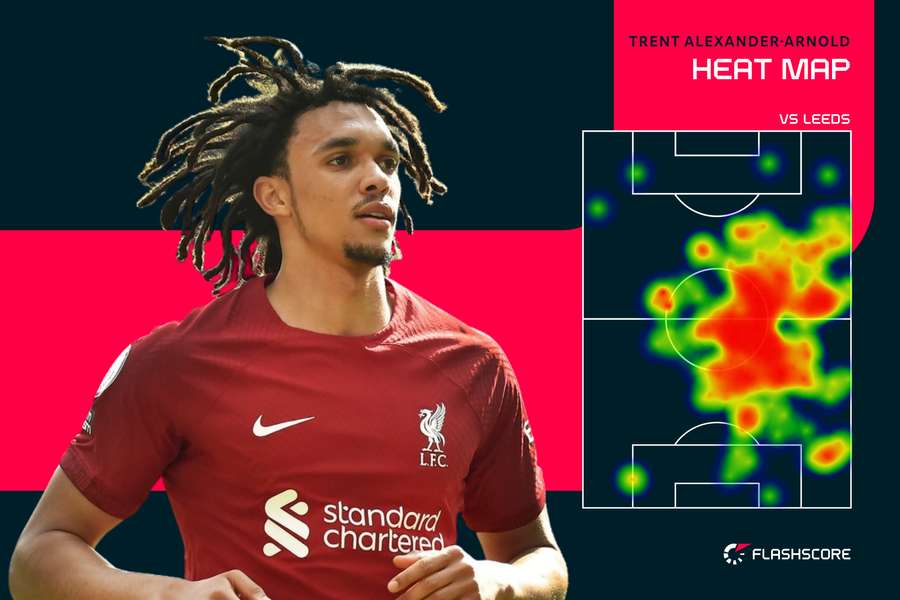Trent Alexander-Arnold's switch to midfield spearheading Liverpool's Champions League push

But as we approach the campaign's business end, Jurgen Klopp’s side are finally piecing together some consistent form and making a late charge toward the Champions League places which, at one stage, looked beyond them.
The Reds are currently unbeaten in five Premier League matches, with the 2-2 against Arsenal at Anfield in early April proving the catalyst for their turnaround in form.
In that clash at Anfield, Liverpool found themselves 2-0 down to the Premier League leaders inside 30 minutes. Yet, Klopp’s men rode out that early storm and quickly grabbed a foothold in the game, with Trent Alexander-Arnold (24) becoming increasingly influential as the contest progressed.
The right-back started the match in his usual position within Liverpool’s familiar 4-3-3 system, yet his behaviours, particularly when Liverpool had possession, noticeably differed compared to what we’d previously seen.
While building play, Alexander-Arnold was drifting into midfield, rather than maintaining a wide position. This formed a double-pivot in the centre of the pitch alongside key central midfielder Fabinho (29). Simultaneously, left-back Andy Robertson (29) would tuck in with Liverpool’s two central defenders to create a 3-2 shape with five Reds' players free to attack ahead.

The move helped to get the England international much more involved in Liverpool’s build-up play. He finished the game having registered one assist and four key passes; no player registered more in the game that day.
Klopp acknowledged the tactical adjustment post-game, stating: “Today, in build-up Trent played more inside, double six, that’s how it is.
"You need to get used to it, obviously. I would say it’s a big step to do it in a game against Arsenal. It opened up different opportunities for us. If you watch it back after we learned to use it."
After playing an instrumental role in helping the Merseyside club come back from 2-0 down to rescue a point in that game, the approach was repeated a week later when Alexander-Arnold put on a masterclass against Leeds United.

In that game, he attempted 136 passes while registering a pass success rate of 91%. He also chipped in with two assists.
The use of Alexander-Arnold as an ‘inverted wing-back’ isn’t unique, and there have been examples of the same elsewhere in the Premier League in recent times. Pep Guardiola has done it with the likes of Joao Cancelo (28), and more recently with John Stones (28).
City’s Catalan coach also used Oleksandr Zinchenko (26) in such a way when he played at the Etihad, and Mikel Arteta has utilised the Ukrainian in a similar manner at the Emirates since his summer switch.
Alexander-Arnold, though, possesses superb technical ability and a passing artillery that can better most, which has made him an extremely dangerous operator in this area of the pitch for Liverpool across recent weeks.
Klopp’s men have scored 13 goals across their past four games, and Alexander-Arnold’s role in that can be captured by looking at his underlying numbers.
In his previous four Liverpool appearances, he has registered five assists, that’s two more than he’d managed across his 28 prior Premier League matches. He’s also accumulated an Expected Assist (xA) total of 2.6 in this time - that’s more than he amassed in his nine league games prior to the draw against Arsenal.
It’s not just Alexander-Arnold who has benefited from this recent switch, but also teammate Mohamed Salah (30). The lethal Egyptian, who often plays ahead of the wing-back, has registered 60+ touches in three of Liverpool’s last four matches, having not exceeded 60 touches in any game prior to the contest against Arsenal.
That’s the added benefit of Alexander-Arnold drifting more centrally, it creates more space for Salah on the right to cause carnage. Four goals from his last four games, plus 18 shots, highlight he’s doing just that.
The question of whether Alexander-Arnold could be converted into a midfielder has been an ongoing debate at Anfield for a while now. It had, up until recently, only been a theoretical scenario.
However, his performances and the impact on the wider Liverpool team within such a role across recent weeks will have given Klopp plenty of food for thought, especially as the club weigh up potential heavy investment in that area of the pitch this summer.
